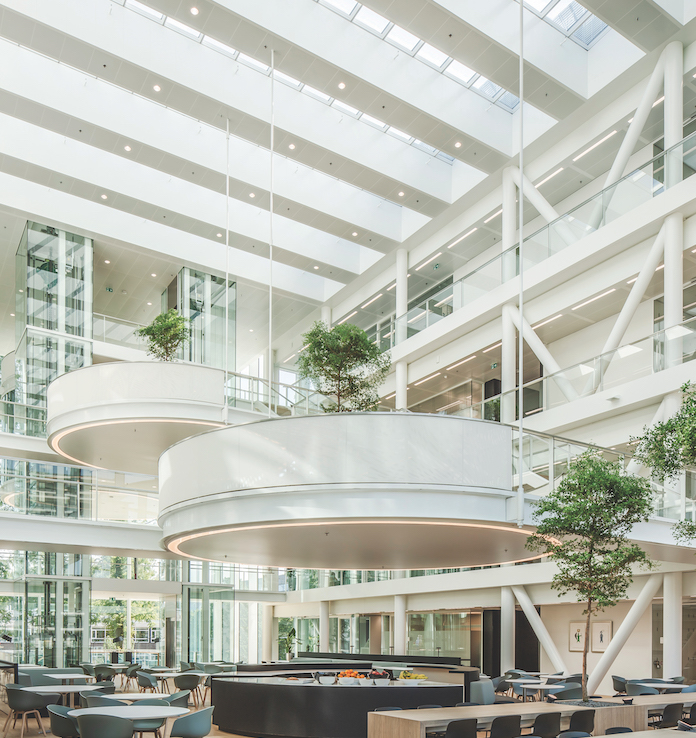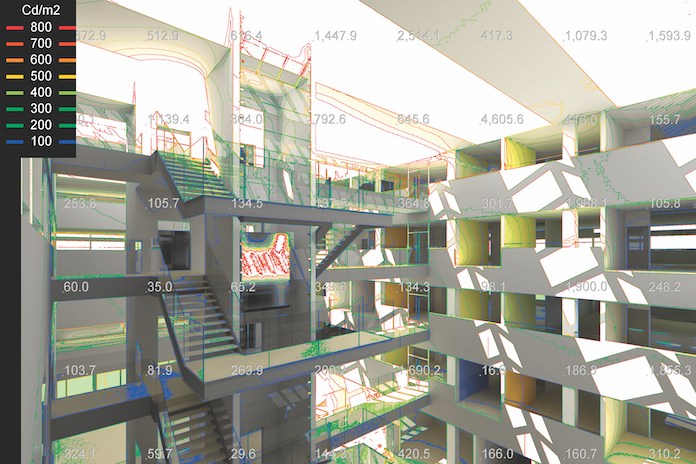
Availability of light impacts on occupants’ mood
Good daylight and air quality are crucial in commercial buildings. In association with Velux Commercial, CM examines how using daylight simulation tools can support a commercial building and its users’ needs through daylight design
The importance of daylight and air quality within commercial buildings cannot be overstated. Not only can natural light reduce the need for electric lighting during the daytime, and lower the energy use of the building, it can also influence both heating and cooling loads, which makes it an important parameter of an energy efficient design. Additionally, recent research has proved that adequate daylight provides an array of health and comfort benefits that make it essential for the wellbeing of building occupants.
Daylight simulation tools can support a commercial building’s compliance and its users’ needs by providing critical overviews of building performance prior to construction. These tools make it possible to evaluate the quantity and distribution of daylight in a room, whilst considering key influential parameters such as window placement, building geometry, external obstruction, interior divisions and material properties.

Velux modular skylights in the atrium of the Genmab research facility in Utrecht
Supporting the implementation of EN 17037
EN 17037, the new European Standard for daylighting in buildings, is helping change the focus of commercial building design, and the role of glazing in those designs, to improve occupant comfort and overall energy efficiency. The need to provide glazed openings and well distributed daylight to interior spaces, whilst reducing artificial lighting use, must be considered with the balance between heat loss and solar gains.
We all understand the importance of light in terms of being able to see and being able to use buildings and spaces for what they are intended. We also understand that artificial light – however well designed it is – is less able to meet these needs than daylight. When we allow natural light to enter our buildings, we are also maintaining a view out and a connection with our wider environment – something that artificial light cannot do.
Light impacts our mood as well – a concept that is not easy to measure through mathematics and physics. The proliferation of technology, and the amount of time we spend staring at screens, is beginning to raise awareness of the types of light we expose ourselves to and the effect it has on sleep and the body’s natural rhythms. We need that same increased awareness when it comes to buildings.
Beyond the provision of daylight for people to be comfortable and able to undertake tasks, there is also the balance between energy use and daylight provision to think about.
Daylight simulation tools can support a commercial building’s compliance with EN 17037 and ensure that from the early stages of design and specification commercial buildings will perform and adhere to the required standards.
Velux Daylight Visualizer
Where high levels of daylight are intended in a public, industrial or commercial building, the daylight design should be assessed at an early stage when it is easiest to make changes.
If daylight design is undertaken from the early stages of a project, it means roof glazing products can be specified in the right size and quantity from the outset. The project therefore benefits from greater certainty, and the glazing can be priced with confidence.
Nicolas Roy, architect, is part of the Daylight, Energy and Indoor Climate team at the Velux Group and specialises in the field of building performance with a focus on daylighting. Over the past 15 years with the Velux Group, Roy’s extensive knowledge of building design, 3D modelling and lighting has helped to shape the development of one of Velux Commercial’s most useful daylighting tools – the Velux Daylight Visualizer.
This free-to-use simulation tool helps to predict and document daylight levels as well as the appearance of a space prior to realisation of the building design. The Daylight Visualizer goes above and beyond the more commonly used 3D visualisation programs by accurately simulating and quantifying daylight levels in interiors.


The Daylight Visualizer applies false colour mapping to highlight daylight distribution
The Daylight Visualizer can:
Calculate daylight factor levels: You can use the Daylight Visualizer to simulate the daylight factor (DF), a commonly used performance indicator for the evaluation of daylight provisions in buildings. The daylight factor is a measure of the amount of diffuse light available at different points inside the building – in relation to the amount of diffuse light available outside the building under unobstructed overcast sky conditions.
Evaluate requirements for daylight provisions in the new European Standard for Daylight in Buildings (EN 17037): Daylight factor simulations can be used to evaluate requirements for daylight provisions in EN 17037, where two specific daylight factor targets need to be achieved over 50% and 95% of the work plane area. The daylight factor targets were defined based on recorded climatic data in each country and relate to a desired illuminance level for the space.
Create or import 3D models: The Daylight Visualizer can import detailed 3D models of buildings from a wide range of CAD/BIM software – including Revit, AutoCAD, ArchiCAD and SketchUp – with one of the supported file formats DWG, DXF, SKP and OBJ.
Perform luminance and illuminance simulations: With the Daylight Visualizer you can run these simulations under different International Commission on Illumination (CIE) sky conditions and apply false colour mapping to visualise the quantity and distribution of daylight in the space.
Instead of using rules of thumb or gut feeling to set out the initial number and size of roof glazing solutions, daylight simulation tools help to eliminate uncertainty.
The building design proposal is then passed to the M&E consultant for compliance verification but, with the bulk of the assessment already done, and with greater certainty that the proposed design is already adequate, the whole process is made much quicker – and with less risk of further design work to accommodate changes.
Learn more about the Velux Daylight Visualizer and how Velux Commercial provides daylight expertise to help you design compliant roof glazing solutions by visiting veluxcommercial.co.uk











